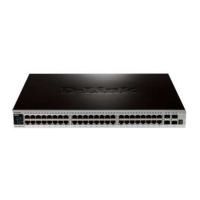DGS-3630 Series Layer 3 Stackable Managed Switch Web UI Reference Guide
334
Parameter Description
Hold Time
Enter the hold time value here. This specifies the length of time to timeout the
keep-alive message. The software will declare a BGP peer dead after the on
timeout. The range is from 0 to 65535 seconds.
Always Compare MED
Select the enable or disable the always compare Multi Exit Discriminator (MED)
feature here. This is used in comparing the MED in best path selection for paths
that are advertised from neighbors in either the same or different autonomous
systems.
Deterministic MED
Select to enable or disable the deterministic MED feature here. This is used to
compare the MED value between all paths received from within the same
autonomous system in the selection of the best route selection.
Default Local Preference
Enter the default local preference value here. The local preference is used to
control the preferred exit point from the local AS to the same destination network.
The local preference will be sent with the route advertised to the iBGP peers. If an
external route is both reachable via the local router and an iBGP peer router, the
local preference value determines the preferred exit point to reach the external
route. The range is from 0 to 4294967295.
MED Confed
Select the enable or disable the MED confederation feature here. When enabled,
the BGP process will compare the MED for the routes that are received from
confederation peers. For routes that have an external AS in the path, the
comparison does not occur.
AS Path Ignore
Select to enable or disable the AS path ignore feature here. When enabled, this
feature is used to ignore the AS path as a discriminating factor in the selection of
the best path.
Compare Router ID
Select to enable or disable the compare router ID feature here. This is used to
configure a BGP process to use the router ID as a tie breaker in best path
selection. If this is enabled, the path with lowest router ID will be selected as the
best when all other attributes are equal.
MED Missing AS Worst
Select to enable or disable the MED missing AS worst feature here. This is used
to configure the BGP process to assign an infinite value to the route if the MED is
missed.
Compare Confederation
Path
Select to enable or disable the compare confederation path feature here. When
enabled, the BGP process will compare the confederation AS path length in best
path selection. The path with shorter the confederation AS path length is
preferred.
Fast External Failover
Select to enable or disable the fast external failover feature here. This is used to
globally enable or disable the fast external failover of BGP sessions for the
directly connected external peers. When enabled, the session is immediately
reset if the link goes down. When disabled, the session will not be reset until the
default hold timer expires.
Aggregate Next Hop Check
Select to enable or disable the aggregate next hop check feature here. This is
used to enable the checking of next hop of the BGP aggregated routes. Only the
routes with the same next hop attribute can be aggregated if the BGP aggregate
next hop check is enabled.
Default IPv4 Unicast
Select to enable or disable the default IPv4 unicast feature here. This is used to
enable the exchange of IPv4 unicast routing information.
Graceful Restart State
Select to enable or disable the BGP graceful restart capabilities for all BGP
neighbors here.
Restart Time
When graceful restart is enabled, enter the restart time here. This specifies the
maximum time needed for neighbors to restart. The range is from 1 to 3600
seconds.
Stalepath Time
When graceful restart is enabled, enter the stalepath time here. This specifies the
maximum time to retain stale paths from restarting neighbors. The range is from 1
to 3600 seconds.
Click the Apply button to accept the changes made.

